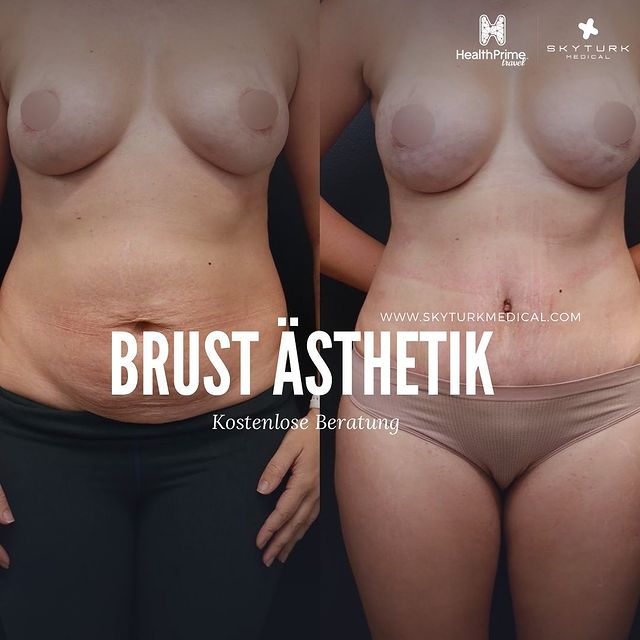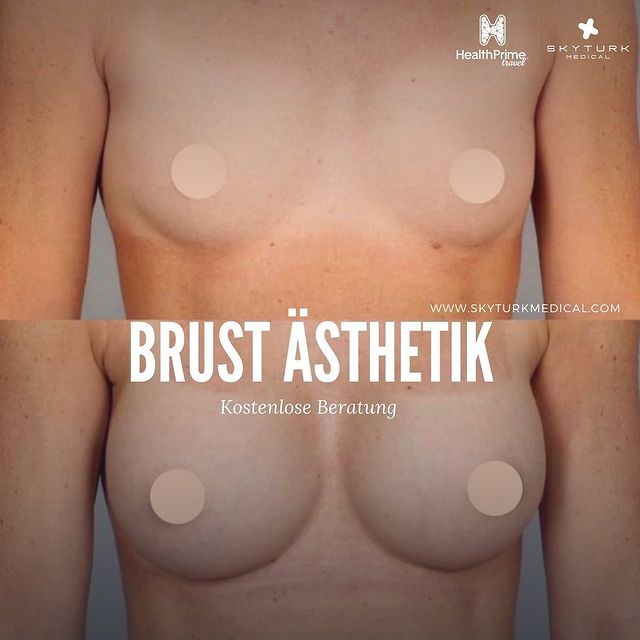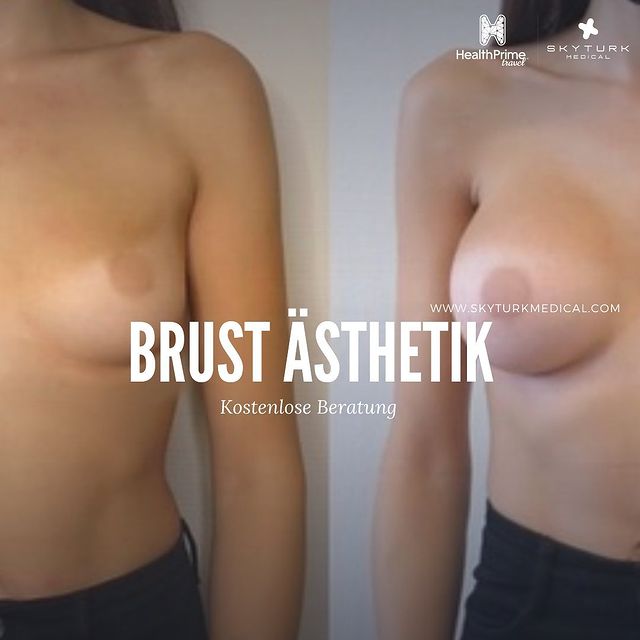



Skyturk Medical is proud of its more than 10.000 Patients from all over the world who have attended in the last 10 years Skyturk Medical one breast augmentation have undergone. As a pioneer of health tourism in Turkey, we introduce you to the excellent results of our patients.
What is breast augmentation? Breast augmentation is a surgical procedure that uses implants or fatty tissue to increase the volume and shape of the breasts. It is an option for women who are unhappy with the size of their breasts or who want to restore their previous breast size after pregnancy or weight loss.
Types of Breast Implants: There are different types of breast implants including silicone implants and saline implants. The article explains the differences between the two options and discusses their pros and cons.
The Surgical Procedure: This section explains the flow of the breast augmentation procedure, including the placement of the implants, the interfaces, and the anesthesia used. Possible complications and risks are also discussed.

Recovery Time and Aftercare: Adequate recovery time is required after breast augmentation to aid in healing. This section explains what to expect after surgery, including pain management, physical activity restrictions, and follow-up visits.
Possible risks and complications: Every surgical procedure carries risks. This part of the article discusses potential risks and complications of breast augmentation, including infection, scarring, and implant failure.
Breast augmentation alternatives: There are also non-surgical breast augmentation options such as using breast enlargement pills or creams. This section examines these alternatives and discusses their effectiveness.

Improved Self-Confidence: Breast augmentation can significantly increase a woman's confidence and self-esteem. By improving the appearance and proportions of the breasts, many women feel more attractive and satisfied with their bodies.
Improved Body Proportions: Women who are unhappy with small or disproportionate breasts can benefit from breast augmentation. By adapting the breast size to the rest of the body, a more harmonious and balanced appearance can be achieved.
Choice of clothing: After a breast augmentation, many women have a larger choice of clothing. They can wear clothes they previously avoided because of their bust size and feel more confident in their style.
Improved physical symmetry: Breast augmentation can lead to improved symmetry in women who have an asymmetrical breast shape. By adjusting the size and shape of the breasts, a more even appearance can be achieved.
Recovering from Pregnancy or Weight Loss: Many women notice changes in the size and shape of their breasts after pregnancy or weight loss. Breast augmentation can help them restore their previous breast size and shape and regain their self-confidence.
Emotional and Psychological Benefits: Women who are unhappy with the appearance of their breasts can suffer from emotional distress and a lack of self-esteem. Breast augmentation can help overcome these negative feelings and develop a positive body image.

7th day of preparation: You will usually be admitted to the hospital the day before the operation. On this day you will make a number of preparations, such as fasting from midnight and preparing for surgery.
8th day of the operation: On the day of the operation, we will perform an abdominal ultrasound and a gastroscopy with twilight sleep. You will then be taken to the operating room, where you will be given general anesthesia. The surgeon then performs the procedure, removing much of the stomach and shaping the remaining portion into a tubular stomach.
9. After the operation: After the gastric sleeve operation, you will be taken to the recovery room where you will be monitored by the nurses and after half an hour you will be taken to the ward and given painkillers. In the first few days after the operation, you should only go through a liquid phase before gradually moving on to pureed foods and finally to solid foods.
10.Hospitalization and Follow-Up: The length of your hospitalization will depend on your individual recovery, but typically can be four to five days. During your stay, nurses will assist you with pain control, wound care, and nutrition. You will receive follow-up instructions, including diet and exercise recommendations.
The decision to undergo breast augmentation is a personal choice that depends on many factors. This article provides an overview of the candidates who are typically considered for breast augmentation, as well as key aspects to consider when making the decision.
Women with low breast volume: Women who are unhappy with the size of their breasts and have low breast volume may be candidates for breast augmentation. This includes women who have underdeveloped breasts due to genetics or other factors.
Women after pregnancy and breastfeeding: Pregnancy and breastfeeding can lead to changes in breast size and shape. Women who notice changes in their breasts after having a baby or breastfeeding and want to restore their previous appearance can consider breast augmentation.
Women with asymmetrical breasts: Some women have a natural asymmetry in their breasts, where one breast is smaller or differently shaped than the other. A breast augmentation can help to improve the symmetry of the breasts and achieve a harmonious appearance.
Women who have lost weight: Women who have experienced significant weight loss and lost volume in their breasts as a result may benefit from breast augmentation. This allows them to restore lost breast volume and improve their body proportions.
Healthy Individual Candidates: For breast augmentation, candidates should be in good general health. It is important that they do not have any serious medical conditions that could increase the risk of the procedure. A qualified plastic surgeon will conduct a thorough evaluation of the patient's health prior to surgery.
While breast augmentation can offer many benefits, it's also important to understand the potential downsides and risks of these surgical procedures. This article provides an overview of some of the possible downsides of breast augmentation that should be considered.
Surgical Risks: As with any surgical procedure, breast augmentation carries certain risks. These include infection, bleeding, scarring, breast asymmetry, and reactions to the implants used. It's important that you understand that complications can occur and that you discuss these risks with your surgeon.
Long-term implications: Although breast implants can usually last a long time, they can cause problems over time. Implant rupture, capsular contracture (hardening of the surrounding tissues) or the need for re-operation can be potential long-term implications. It is important to be aware that breast augmentation may require additional procedures or maintenance in the future.
Body Image Changes: It is important to have realistic expectations of the outcome of breast augmentation. Some women may have difficulty adjusting to their new appearance or coping with changes in their body image after surgery. A thorough consultation with a plastic surgeon can help set realistic expectations and discuss potential psychological implications.
Limitations and Recovery Time: Adequate recovery time is required after breast augmentation to aid in healing. During this time, certain activities will need to be restricted and you may experience inconveniences and temporary restrictions. It is important that you prepare for these limitations and follow your surgeon's instructions to ensure the best possible recovery.
Breast augmentation usually involves using an implant to change the volume and shape of the breasts. The procedure is performed under general anesthesia and the surgeon makes a small incision in the breast crease to insert the implant. There are different implant shapes and sizes, which are selected depending on the individual needs of the patient.
Recovery after breast augmentation can vary from person to person. Swelling, bruising and slight pain may occur in the first few days after the procedure. However, most women can return to their normal activities within a week or two. Sports activities and heavy physical exertion should be avoided for a few weeks.
There are different types of breast implants including silicone gel implants and saline implants. Each type of implant has its own advantages and disadvantages, and the choice depends on the individual wishes and needs of the patient. Your surgeon will tell you about the different options and help you decide.
Breast augmentation can provide long-term results, but it's important to note that implants don't last forever. Over time, changes in the breast can occur, such as implant rupture or capsular contracture. It is possible that additional interventions may be required in the future to maintain or improve results.
As with any surgical procedure, there are certain risks and possible complications associated with breast augmentation. These include infection, bleeding, scarring, breast asymmetry, and reactions to the implants. It's important to discuss these risks with your surgeon and learn about possible complications.
Women who are unhappy with the size or shape of their breasts can be good candidates for breast augmentation. It is important that you are in good general health and have realistic expectations of the results. A qualified plastic surgeon will evaluate your unique situation and help you make the best decision.